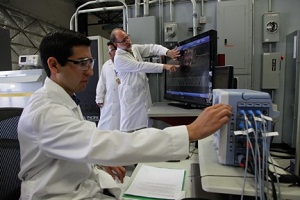SCE testing smart grid components to add in local solar
 More and more distributed generation is entering the electrical grid, which is largely based on delivering power the way it was over a century ago—supplying electricity from afar. But as more solar gets added in—particularly distributed generation—it requires new, smarter substations, inverters and capacitors.
More and more distributed generation is entering the electrical grid, which is largely based on delivering power the way it was over a century ago—supplying electricity from afar. But as more solar gets added in—particularly distributed generation—it requires new, smarter substations, inverters and capacitors.
Southern California Edison, a subsidiary of Edison International (NYSE: EIX), is at the vanguard of distributed generation with plans to add in a total of 500 megawatts of distributed generation and its testing solutions to make the electricity grid of tomorrow, safer and faster than the grid of the past and today.
On June 13, the company announced that it brought online four distributed generation photovoltaic arrays (three rooftops, one ground-mount), totaling 7 megawatts of generation. That’s about enough to power 4,550 average homes. In all, the company now has 15 such stations up and running, totaling about 28.75 megawatts of distributed solar in its grid, said SCE spokesperson Gil Alexander.
“The difference between previous announcements that we were bringing more [solar] online and today is there is coming a point when we’re not be going to be able to connect as much solar as we want to unless we redesign neighborhood power circuits,” Alexander said.
The power grid, as currently designed, is based on central power generation flowing in one direction and being distributed to where it’s needed. It’s like going home on an Interstate, taking an exit, and turning onto progressively smaller, one-way roads until reaching home.
As such, power lines get progressively smaller as electricity nears its end-use point. It travels through substations and capacitors to keep the flow of electricity even throughout the grid, Alexander said.
“Now we come along and have ambitious plans to connect these neighborhood power plants, and we’re plugging them right into distribution circuits, and the first thing that happens is power flows in both directions,” he said. The grid’s not set up for two-way traffic.
Utilities have to manage the voltage and keep it consistent, according to Alexander.
“The most significant change is changing the components, such as capacitors that can sense power going in both directions,” he said.
Substations, capacitors and inverters need to be able to manage the various flows of electricity, condition it and decide whether or not to shut down if there’s a large spike in voltage.
Again likening it to traffic, imagine stoplights with sensors to detect the flow of traffic and respond accordingly. That’s what tomorrow’s smart-grid components must be able to do.
“If we’re going to continue to attach a lot more solar generation, then the neighborhood power circuit of the past must be replaced with the neighborhood solar circuit of the future,” Alexander said. “What happens if a substation loses its source of power? In current technology, the inverter shuts down—our response is time out.”
But with smart-grid technologies, new, smart solar inverters and capacitors could address the issue differently, and still provide some power as needed, he said.
The company is now testing smart-grid components for distributed generation and plans to start real-world testing this year, Alexander said.
Image courtesy of Southern California Edison.



